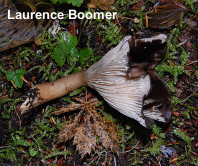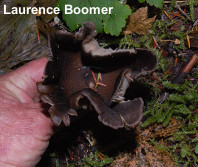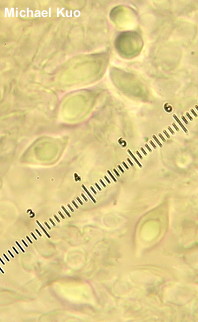| Major Groups > Gilled Mushrooms > Pale-Spored > Clitocyboid Mushrooms > Ampulloclitocybe avellaneialba |

|
Ampulloclitocybe avellaneialba [Basidiomycota > Agaricales > Hygrophoraceae > Ampulloclitocybe...] by Michael Kuo This is a distinctive clitocyboid mushroom from the Pacific Northwest: it has a dark brown cap that contrasts nicely with its decurrent white gills, it grows from the wood or woody debris of conifers, and, under the microscope, it features very funky, swollen-fusiform spores. Ampulloclitocybe clavipes is similar, but grows on the ground, is usually paler, and features very different, ellipsoid spores. I am following Bigelow (1982a) and Gregory (2007) in applying the name avellaneialba to the species described here, but I am not entirely convinced that the mushroom originally described by Murrill (1913) is actually the same. Murrill called the cap color "avellaneous to dark-fuliginous" in his description, but emphasized "avellaneous" in his comments and in the species epithet itself, which presumably is meant to reflect the contrast between the avellaneous cap and the white (alba) gills. "Avellaneous" is best translated to "hazel" in contemporary English—not at all a good match for the cap color of the mushroom currently called Ampulloclitocybe avellaneialba. Additionally, Murrill describes the spores as "globose," and while Murrill is not known for his microscopic rigor, even his microscope and limited attention to such things would note the spores of the mushroom featured here as decidedly not globose. I find no study of Murrill's type collection by Bigelow, Gregory, or Harmaja—which is odd, because Bigelow (1982b) putatively studied all of Murrill's Clitocybe types, and included study of the Clitocybe atrialba and Clitocybe brunnescens types, which come immediately before and after Clitocybe avellaneialba in Murrill's original publication. The type collection in question is housed in the New York Botanical Garden (where Murrill's handwritten notes say the cap is "avel to dark-avel"), just waiting for someone to study it. Thanks to Laurence Boomer for collecting, documenting, and preserving Ampulloclitocybe avellaneialba for study; his collection is deposited in The Herbarium of Michael Kuo. Description: Ecology: Saprobic; growing alone or gregariously on the well-decayed deadwood of conifers; sometimes growing from buried deadwood and appearing terrestrial; fall and early winter; Pacific Northwest, northern California, and the northern Rocky Mountains. The illustrated and described collection is from Oregon. Cap: 2–10 cm; at first flat with a slightly incurved margin, becoming centrally depressed and, eventually, vase-shaped, with an uplifted margin; very finely hairy, or nearly bald; moist; dark brown. Gills: Running deeply down the stem; close; short-gills frequent; whitish. Stem: 4–10 cm long; 1–2 cm thick; more or less equal; bald or minutely hairy; pale brown. Flesh: Whitish; unchanging when sliced. Odor and Taste: Not distinctive. Spore Print: Reported by Bigelow (1982a) as white. Microscopic Details: Spores 6–10 x 3–4.5 µm; widely fusiform-limoniform; smooth; thick-walled; hyaline in KOH; inamyloid. Hymenial cystidia not found. Pileipellis a cutis with areas of ascending hyphae; brown in KOH; elements 5–7.5 µm wide, smooth, clamped at septa. REFERENCES: (Murrill, 1913) Harmaja, 2003. (Smith, 1975; Bigelow, 1982a; Phillips, 1991/2005; Lincoff, 1992; Gregory, 2007; Trudell & Ammirati, 2009.) Herb. Kuo 10231303. This site contains no information about the edibility or toxicity of mushrooms. |
< © MushroomExpert.Com |
|
Cite this page as: Kuo, M. (2016, December). Ampulloclitocybe (Clitocybe) avellaneialba. Retrieved from the MushroomExpert.Com Web site: http://www.mushroomexpert.com/ampulloclitocybe_avellaneialba.html |


